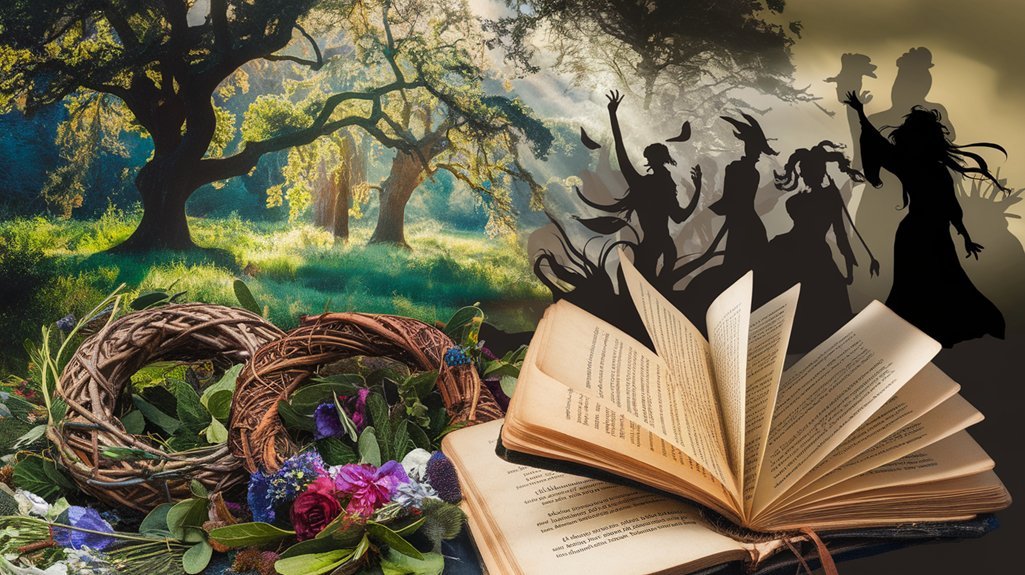As an Amazon Associate I earn from qualifying purchases.
Embark on a journey through magic and unravel the intricate web of witchcraft traditions. You'll explore ancient beliefs, uncover the role of herbs in medieval practices, and witness African shamanic rituals. Consider how societal dynamics and gender roles shape these practices, while examining the intersection of religion and magic. As you traverse modern revivals and pop culture portrayals, you'll find witchcraft as a rich tapestry of human experience waiting to be discovered.
Key Takeaways
- Witchcraft traditions integrate ancient rituals, connecting physical and spiritual worlds through symbolic tools and plants with spiritual significance.
- Herbal magic uses plants for both physical healing and symbolic meanings, reflecting cultural beliefs and practical applications.
- African shamanism emphasizes ancestral connections, utilizing rituals and sacred herbs for spiritual guidance and protection.
- Modern witchcraft incorporates digital platforms, enabling global connections and blending ancient practices with contemporary cultural dynamics.
- Popular culture reinterprets witchcraft, often symbolizing empowerment and rebellion, reflecting evolving societal views on power and identity.
The Roots of Witchcraft: An Exploration of Early Beliefs

While exploring the roots of witchcraft, it's essential to delve into the early beliefs that shaped its foundation. You'll find that ancient rituals were at the heart of these practices, often serving as a bridge between the physical and spiritual worlds. These rituals weren't merely symbolic; they represented profound spiritual symbolism, connecting practitioners to elemental forces and deities.
In various cultures, these early beliefs integrated with societal norms, reflecting the community's understanding of the universe. You might notice that spiritual symbolism was prevalent in the use of symbols and tools, each carrying a specific meaning and intent. These symbols acted as conduits for energy, intention, and communication with otherworldly entities.
Herbal Magic: The Role of Plants in Medieval European Witchcraft
In medieval Europe, you would find that herbal magic formed a cornerstone of witchcraft practices, where plants weren't just used for their physical properties but also for their symbolic meanings. You'd notice that each herb carried its own mystique, often intertwined with rituals aimed at healing and protection. These practices illustrate how deeply intertwined cultural beliefs and natural remedies were, reflecting both practical and spiritual dimensions in the lives of medieval witches.
Medieval Herbal Spellcraft
Throughout medieval Europe, the practice of herbal spellcraft intertwined deeply with everyday life, shaping a unique facet of witchcraft traditions. You'd find that herbs served not just as herbal remedies but also crucial spell components. People relied on these plants for both healing and mystical purposes, believing that each held specific powers and properties.
In your exploration of medieval herbal spellcraft, notice how knowledge of plants was a valued skill. Wise women and cunning folk often acted as community healers, combining practical uses with mystical beliefs. They'd use herbs like mugwort and vervain, blending them into potions or charms. This knowledge wasn't just folklore; it reflected an understanding of nature's influence, forming the basis of many practices rooted in the magical world.
Plants' Symbolic Meanings
Herbal spellcraft in medieval Europe wasn't just about using plants for practical purposes; it also embraced a rich tapestry of symbolic meanings tied to each herb. You'll find that plants like rosemary and sage were more than just culinary ingredients. Rosemary symbolized remembrance and fidelity, making it a staple in love charms. Sage, revered for its wisdom, was often used to invoke protection. Understanding these symbolic significances was crucial for practitioners. Medieval witches relied on botanical lore to select the right plants, believing each herb's spiritual energy could influence outcomes. This intricate relationship between herbs and symbolism highlights the depth of medieval witchcraft. The symbolic significance of plants wasn't merely superstition; it was an essential part of their magical practices and cultural beliefs.
Healing and Protection Rituals
While medieval witchcraft often conjures images of mysterious incantations and arcane symbols, its foundations rested firmly on the practical use of plants in healing and protection rituals. You'd find that herbal remedies were at the heart of these practices, where plants like sage and rosemary played crucial roles. They weren't just for flavoring meals; they were believed to have properties that could heal ailments and offer spiritual cleansing. In a time when medical knowledge was limited, these natural ingredients provided tangible benefits and peace of mind. By using these plants, practitioners aimed to ward off malevolent spirits and bolster the body's defenses. Thus, understanding the cultural significance of these practices reveals their importance in medieval society's approach to health and protection.
African Shamanism: Rituals and Ceremonies of Spiritual Healers
In African shamanism, you observe a profound connection to ancestors, where spiritual healers call upon ancestral wisdom during rituals. They often incorporate sacred herbs and plants, believed to possess healing and protective properties, into their ceremonies. Additionally, spirit animals play a crucial role, guiding practitioners and offering insights from the spiritual realm.
Ancestral Connections and Wisdom
Because African shamanism is deeply rooted in the cultural and spiritual fabric of many African communities, you'll find that ancestral connections and wisdom play a crucial role in its practices. Ancestral rituals often serve as a bridge to the past, allowing shamans to access the knowledge of wisdom keepers who have long guided their people. These rituals are not just ceremonial; they're essential for maintaining the community's spiritual health. You'll notice that these ceremonies often involve invoking ancestors to seek guidance or blessings. This connection fosters a sense of continuity and identity, linking present generations with their forebears. By honoring these ties, shamans ensure that the accumulated wisdom of the past informs the community's present and future, creating a resilient cultural tapestry.
Sacred Herbs and Plants
Ancestral connections in African shamanism don't only manifest through rituals; they also find expression in the use of sacred herbs and plants. You'll discover that these sacred plants have profound spiritual significance, often cultivated in magical gardens. Shamans use them to create potent herbal remedies, believed to bridge the physical and spiritual realms. Each plant carries unique symbolism, with specific uses in healing ceremonies and spiritual practices.
In many African traditions, herbal knowledge is passed down through generations, ensuring that the wisdom of plant symbolism remains alive. You might notice how these plants are more than just tools; they're revered entities, embodying ancient knowledge and power. This deep respect for nature illustrates a harmonious relationship between humans and the spiritual world.
Spirit Animal Guidance
Spirit animals in African shamanism serve as powerful guides and protectors, leading individuals on spiritual journeys and providing insights into their inner selves. You'll find that these spirit guides, often represented through animal symbolism, play a crucial role in rituals and ceremonies conducted by spiritual healers. In this tradition, each animal embodies specific attributes, offering wisdom and strength to those seeking guidance. For example, the lion might represent courage and leadership, while the owl symbolizes wisdom and intuition. Shamans communicate with these spirit animals through meditation and ritual, creating a bridge between the physical and spiritual realms. Understanding this connection helps you appreciate the profound impact of animal symbolism in African shamanism, which emphasizes harmony and balance with nature.
The Influence of Witchcraft on Society and Culture
Although often shrouded in mystery and misconceptions, witchcraft has undeniably shaped various facets of society and culture throughout history. When you examine its influence, you'll notice how it has permeated literature, art, and folklore, offering rich narratives that reflect societal perceptions. These perceptions, often fueled by fear or fascination, have led to both the vilification and romanticization of witches.
In many cultures, witchcraft has been a symbol of rebellion against oppressive structures, serving as a form of empowerment for marginalized groups. You can see its impact in how communities have navigated social norms, using witchcraft as a tool for resistance or assimilation. Additionally, it has influenced legal systems, as seen in historical witch trials that targeted nonconformists. Yet, despite these complex roles, witchcraft continues to inspire curiosity and creativity, prompting a deeper exploration of human belief systems and cultural identities across the globe.
The Intersection of Religion and Magic in Witchcraft

As you explore the intricate tapestry of witchcraft, its intersection with religion and magic becomes evident, revealing how these elements have coexisted and evolved together. You'll notice that witchcraft often incorporates religious elements, where rituals hold profound significance. These rituals aren't random acts but meticulously crafted practices aiming to establish a divine connection. In many traditions, magic isn't separate from spiritual beliefs but deeply intertwined, influencing how practitioners perceive and interact with the world.
Consider these observations:
- Ritual Significance: Each ritual is imbued with meaning, acting as a bridge between earthly life and spiritual realms.
- Divine Connection: Practitioners seek connections with divine entities, often invoking deities or spirits for guidance and power.
- Cultural Context: Witchcraft practices reflect cultural beliefs, where religion and magic merge to form a cohesive worldview.
Modern Witchcraft: Revival and Evolution in the Contemporary World
In recent years, modern witchcraft has experienced a significant revival, adapting to contemporary cultural contexts while maintaining its mystical roots. You'll find that this resurgence is characterized by eclectic practices that blend traditional elements with new-age philosophies. Digital witchcraft has emerged as a key component, connecting practitioners worldwide through online platforms, fostering a vibrant, supportive community.
Here's a look at the evolution and impact:
| Aspect | Modern Influence |
|---|---|
| Eclectic Practices | Combines diverse traditions and beliefs |
| Digital Witchcraft | Online forums and social media |
| Accessibility | Information and tools widely available |
| Community Building | Global connections and collaborations |
| Innovation | Integration of technology and magic |
As you explore these modern adaptations, observe how technology and global connectivity have reshaped witchcraft's landscape. This evolution reflects a dynamic interplay between ancient wisdom and contemporary innovation, offering new possibilities for personal growth and spiritual exploration.
Gender and Power Dynamics in Witchcraft Traditions

When exploring witchcraft traditions, it's vital to consider how gender and power dynamics have historically shaped these practices. Across cultures, feminine power often intertwines with magical authority, challenging patriarchal oppression. Women, traditionally seen as spiritual leaders, have wielded influence within their communities, navigating complex gender roles. However, societal perceptions have frequently cast such power as threatening, leading to witch hunts aimed at quelling female autonomy.
You'll notice that:
- Feminine power often aligns with community dynamics, where spiritual leadership becomes a counterbalance to patriarchal structures.
- Witch hunts historically reflect societal perceptions of female authority as dangerous, reinforcing gender roles that suppress women's voices.
- Magical authority transcends gender, yet patriarchal oppression distorts this balance, skewing the understanding of witchcraft practices.
Understanding these dynamics provides insight into how witchcraft traditions have persisted and adapted, despite external pressures aiming to diminish their significance.
Witchcraft in Popular Culture: From Folklore to Film
Although often romanticized or misunderstood, witchcraft's portrayal in popular culture offers a fascinating lens into its evolution from folklore to film. You can trace its journey from ancient tales to modern media, where witchcraft symbolism is both preserved and transformed. In folklore, witches were often depicted as mysterious figures wielding secret powers, deeply embedded in cultural fears and beliefs. As you move into cinematic portrayals, films like "The Craft" or "Practical Magic" reinterpret these symbols, blending traditional elements with contemporary themes.
In movies, witchcraft often represents rebellion, empowerment, or otherness, diverging from the often malevolent portrayal of folklore. Cinematic portrayals offer a space for reimagining witches as complex characters, challenging societal norms and embodying personal freedom. By examining these portrayals, you gain insights into how cultural perceptions of witchcraft have shifted, reflecting broader changes in society's views on power, gender, and identity.
Frequently Asked Questions
How Did Witchcraft Practices Differ Between Rural and Urban Areas?
In your exploration, you'll notice rural rituals often emphasize nature and local customs, while urban beliefs focus on eclectic, diverse influences. Rural areas may maintain traditional practices, whereas cities adapt witchcraft to contemporary, cosmopolitan lifestyles.
What Are Common Misconceptions About Witchcraft?
You often encounter witchcraft stereotypes, like believing all practitioners perform harmful spells. Historical witchcraft actually includes healing and community roles. Misconceptions arise from cultural context shifts and media portrayals, not always reflecting detailed observations or objective analysis.
How Do Different Cultures Define a "Witch"?
Did you know 80% of cultures view witches differently? Cultural definitions vary, with historical perspectives shaping these views. You'll notice some see witches as healers, while others portray them as malevolent figures, highlighting diverse cultural narratives and beliefs.
Are There Ethical Guidelines in Modern Witchcraft Practices?
You'll find that modern witchcraft often includes ethical practices rooted in harm none and respect for nature. Different traditions may emphasize these guidelines differently, but modern beliefs generally prioritize personal responsibility and the interconnectedness of all beings.
How Is Witchcraft Represented in Children's Literature?
In children's literature, magical themes often highlight character archetypes like the wise witch or the mischievous trickster. You see these figures teaching lessons, providing guidance, and exploring moral complexities within diverse cultural contexts, enriching young readers' understanding.
Conclusion
You've journeyed through the intricate world of witchcraft, seeing how it intertwines with cultural identity and societal norms. Imagine a modern-day Wiccan in New York, blending ancient Celtic rituals with urban life, symbolizing witchcraft's evolution. This adaptability underscores magic's enduring relevance, reflecting gender roles and spiritual quests. By understanding these traditions, you appreciate witchcraft as a rich tapestry of human expression, ever-evolving yet deeply rooted in shared cultural heritage. Your journey through magic continues, shaping your perspective.
Amazon and the Amazon logo are trademarks of Amazon.com, Inc, or its affiliates.


